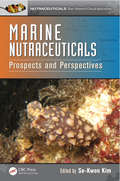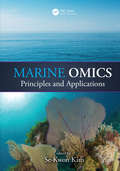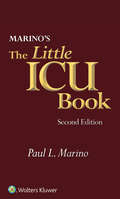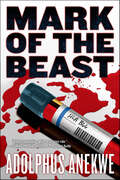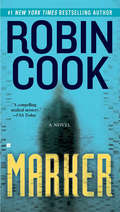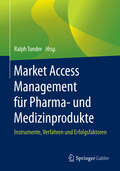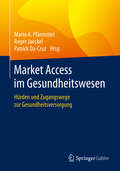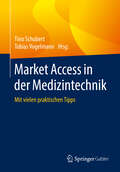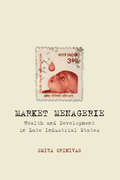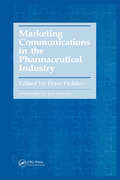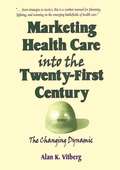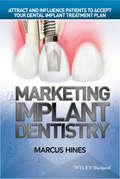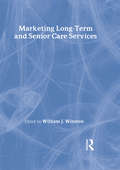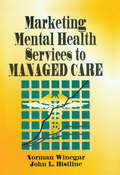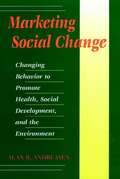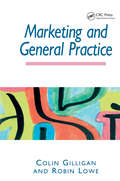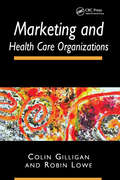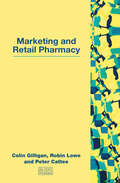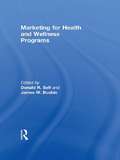- Table View
- List View
Marine Niche: Translational Research
by Chaitanya G. Joshi Neelam M Nathani Chandrashekar Mootapally Indra R. Gadhvi Bharat MaitreyaThis book offers a comprehensive study of biological molecules acquired from marine organisms, which have been exploited for drug discovery with the aim to treat human diseases. Biomolecules have potential impacts on a diverse range of fields, including medical and pharmaceutical science, industrial science, biotechnology, basic research, molecular science, environmental science and climate change, etc. To understand and effectively apply medicinally important biomolecules, multidisciplinary approaches are called for. The ocean remains a rich biological resource, and the vast untapped potential of novel molecules from marine bio-resources has caught the interest of more and more researchers. These novel biological compounds have never been found in terrestrial or other ecosystems, but only in this rich niche. Advances in sampling techniques and technologies, along with increased funding for research and nature conservation, have now encouraged scientists to look deeper in the waters. Aquaculture supports both tremendous seafood production and the bulk production of marine-derived drugs. Furthermore, molecular methods are now being extensively employed to explore the untapped marine microbial diversity. With the help of molecular and biotech tools, the ability of marine organisms to produce new biosynthetic drugs can be greatly enhanced. This book provides an extensive compilation of the latest information on marine resources and their undisputedly vital role in the treatment of diverse ailments.
Marine Nutraceuticals: Prospects and Perspectives (Nutraceuticals)
by Se-Kwon KimThere is a great deal of consumer interest in natural bioactive substances due to their health benefits. Offering the potential to provide valuable nutraceuticals and functional food ingredients, marine-derived compounds are an abundant source of nutritionally and pharmacologically active agents, with both chemical diversity and complexity. Functio
Marine OMICS: Principles and Applications
by Se-Kwon KimThis book provides comprehensive coverage on current trends in marine omics of various relevant topics such as genomics, lipidomics, proteomics, foodomics, transcriptomics, metabolomics, nutrigenomics, pharmacogenomics and toxicogenomics as related to and applied to marine biotechnology, molecular biology, marine biology, marine microbiology, environmental biotechnology, environmental science, aquaculture, pharmaceutical science and bioprocess engineering.
Marine Organisms as Model Systems in Biology and Medicine (Results and Problems in Cell Differentiation #65)
by Jacek Z. Kubiak Malgorzata KlocThis book highlights the potential advantages of using marine invertebrates like tunicates, echinoderms, sponges and cephalopods as models in both biological and medical research. Bioactive compounds found in marine organisms possess antibacterial, antifungal, anti-diabetic and anti-inflammatory properties, and can affect the immune and nervous systems. Despite substantial research on the medicinal attributes of various marine invertebrates, they are still very much underrepresented in scientific literature: the majority of cell, developmental and evolutionary scientific journals only publish research conducted on a few well-known model systems like Drosophila melanogaster or Xenopus laevis. Addressing that gap, this book introduces readers to new model organisms like starfish or nemertera. By showing their benefits with regard to regeneration, stem cell research and Evo-Devo, the authors provide a cross-sectional view encompassing various disciplines of biological research. As such, this book will not only appeal to scientists currently working on marine organisms, but will also inspire future generations to pursue research of their own.
Marine Pharmacognosy: Trends and Applications
by Se-Kwon KimDiverse and abundant, marine-derived bioactive compounds offer a plethora of pharmacologically active agents with the potential to produce valuable therapeutic entities. Marine-derived organisms, including some macroalgae, microalgae, blue-green algae, invertebrates, and vertebrates-valued in traditional Chinese medicine since ancient times-are now
Marine-Derived Biomaterials for Tissue Engineering Applications (Springer Series in Biomaterials Science and Engineering #14)
by Besim Ben-Nissan Andy H. ChoiThis book presents the latest advances in marine structures and related biomaterials for applications in both soft- and hard-tissue engineering, as well as controlled drug delivery. It explores marine structures consisting of materials with a wide variety of characteristics that warrant their use as biomaterials. It also underlines the importance of exploiting natural marine resources for the sustainable development of novel biomaterials and discusses the resulting environmental and economic benefits. The book is divided into three major sections: the first covers the clinical application of marine biomaterials for drug delivery in tissue engineering, while the other two examine the clinical significance of marine structures in soft- and hard-tissue engineering, respectively. Focusing on clinically oriented applications, it is a valuable resource for dentists, oral and maxillofacial surgeons, orthopedic surgeons, and students and researchers in the field of tissue engineering.
Marino's The Little ICU Book
by Paul L. Marino Samuel M. GalvagnoQuick lookup for the most essential info in critical care! Ideal for quick reference at the bedside, The Little ICU Book is a condensed, compact version of The ICU Book, Dr. Marino’s best-selling comprehensive intensive care reference.The Little ICU Book zeroes in on only the essentials for the hands-on care of critically ill adult patients. Its fast-access format makes it an indispensible resource for residents as well as busy critical care physicians.
Marital Conflict and Children
by Patrick Davies E. Mark CummingsFrom leading researchers, this book presents important advances in understanding how growing up in a discordant family affects child adjustment, the factors that make certain children more vulnerable than others, and what can be done to help. It is a state-of-the-science follow-up to the authors' seminal earlier work, Children and Marital Conflict The Impact of Family Dispute and Resolution. The volume presents a new conceptual framework that draws on current knowledge about family processes; parenting; attachment; and children's emotional, physiological, cognitive, and behavioral development. Innovative research methods are explained and promising directions for clinical practice with children and families are discussed.
Mark of the Beast
by Adolphus AnekweMark of the Beast: A searing medical thriller by Adolphus A. Anekwe, a renowned doctor, about the ramifications of isolating a gene that causes violent behavior Dr. Regina Dickerson is a Catholic physician in San Diego who has discovered that there is a certain genetic marker that indicates the carrier is prone to psychotic violence. Working on blood from prison inmates, her theory begins to prove itself time and again with violent offenders. The variety of crimes is diverse: one couple murders their children for organ money, another man kidnaps young girls to seduce and kill them, yet another has a penchant for cyanide. As Dickerson's work begins to show results and catches the attention of the media, people begin to fear that witch hunts and Spanish Inquisition–style mayhem will result if forcible testing is carried out. Meanwhile, a race begins to find a cure. With science and religion at odds, Dickerson must find her own answers while trying to escape those who want to put an end to her inflammatory research. At the Publisher's request, this title is being sold without Digital Rights Management Software (DRM) applied.
Marker (Jack Stapleton / Laurie Montgomery #5)
by Robin CookWith his signature blend of suspense and science, Robin Cook delivers an electrifying page-turner that delves into the murky ethics of developing genomic medicine and modern-day health care.
Market Access Management für Pharma- und Medizinprodukte: Instrumente, Verfahren und Erfolgsfaktoren
by Ralph TunderDie pharmazeutische Industrie steht im deutschen Gesundheitswesen häufig im Mittelpunkt kontroverser Kostendiskussionen. Als Resultat zielten die Maßnamen der Gesundheitspolitik in den letzten Jahren vorrangig auf (Kosten-)regulierungen der Arzneimittelindustrie ab, deren bisheriger Höhepunkt die Einführung des AMNOG im Jahr 2011 darstellte. Die bis dato freie Preisbildung wurde abgelöst durch ein zweistufiges Verfahren bestehend aus Nutzenbewertung und Preisverhandlung. Diese gravierenden Veränderungen der gesetzlichen Rahmenbedingungen für die Arzneimittelindustrie hatten einen erheblichen Bedeutungszuwachs des Themas Market Access zur Folge. Die Motivation zur Erstellung des Buches ist es, eine Publikation zu schaffen, die nicht nur den aktuellen Status widerspiegelt, sondern vielmehr auch die wesentlichen Instrumente und Verfahrensweisen aufzeigt und auch kritisch hinterfragt. Der Leser soll so einen Einblick in die Materie als auch nötiges Rüstzeug bei der konkreten Umsetzung erlangen. Das Buch dient dazu, Market Access Managern oder Interessierten fundiertes Hintergrundwissen zu vermitteln.
Market Access im Gesundheitswesen: Hürden und Zugangswege zur Gesundheitsversorgung
by Mario A. Pfannstiel Patrick Da-Cruz Roger JaeckelDer Zugang zu medizinischen Versorgungsleistungen im Gesundheitswesen ist mit Chancen, Herausforderungen, Reformen, Barrieren und Lösungsansätzen verbunden, die sich zunehmend durch neue Produkte und Dienstleistungen und durch die digitale Transformation der Branche ergeben. Auch ressourcenbezogene Handlungsfelder bilden für den Market Access eine zunehmend stärker zu beachtende Steuerungsgröße, um die Grundlagen für eine bedarfsgerechte Versorgung zu schaffen. Besondere Herausforderungen ergeben sich im Kontext von Arzneimitteln und Medizinprodukten: Aspekte der Zulassungsharmonisierung im europäischen Kontext gewinnen künftig an Bedeutung. Eine zentrale Frage besteht in diesem Zusammenhang in der Nutzenbewertung von Produkten, die sowohl medizinische als auch ökonomische und sonstige Nutzenkategorien umfassen. Da die Industrie zunehmend Lösungspakete anbietet, die aus Produkten und Dienstleistungen bestehen, müssen Verfahren der Nutzenbewertung entsprechend weiterentwickelt werden. Digitale Begleitangebote für Produkte erweitern abermals die Nutzenpositionen und müssen ebenfalls berücksichtigt werden, wie auch die zunehmende Individualisierung von Therapien weitere Fragen aufwirft. Das vorliegende Fachbuch setzt sich mit den genannten Rahmenbedingungen medizinischer Versorgung und mit der Nutzen- und Methodenbewertung neuer Arzneimittel und Medizinprodukte auseinander. Entscheidungsträger aus der Gesundheitspolitik, Wissenschaftler sowie Verantwortliche aus den Versorgungsbereichen und dem öffentlichen Sektor erhalten wertvolle Hinweise und Anregungen.
Market Access in der Medizintechnik: Mit vielen praktischen Tipps
by Tino Schubert Tobias VogelmannDer Marktzugang von Medizinprodukten wird zunehmend komplexer. Einerseits werden Produkte technisch immer anspruchsvoller, andererseits wandeln sich die nationalen und internationalen Regulierungen zur Zulassung kontinuierlich. Zu einem erfolgreichen Marktzugang gehört neben der Zulassung aber auch die Erstattungsfähigkeit durch die gesetzliche Krankenversicherung. Dieses Buch hat daher den Anspruch, praktische Hinweise zur Zulassung und Erstattung für Ihre Marktzugangsstrategien zu geben.
Market Access of Traditional Chinese Medicinal Product in the EU under WTO Legal Framework (Economic and Financial Law & Policy – Shifting Insights & Values #5)
by Saisai WangThis book presents an in-depth analysis of issues in trade law and EU pharmaceutical law concerning market access for traditional Chinese medicinal products. It discusses these issues from the standpoints of fundamental law, international law and EU law, so to offer a comprehensive perspective. Specifically, it points out the core legislative issues for EU policymakers who deal with market access for traditional medicinal products; describes the relation between law and science; and offers essential information on herbal medicinal product registration in the EU. Further, it compares EU law and Chinese law in this regard, which can offer inspirations for readers from other counties that have similar medicinal products. The book uses straightforward, accessible language to break down the key issues involved.
Market Menagerie: Health and Development in Late Industrial States
by Smita SrinivasMarket Menagerieexamines technological advance and market regulation in the health industries of nations such as India, Brazil, South Africa, Nigeria, and China. Pharmaceutical and life science industries can reinforce economic development and industry growth, but not necessarily positive health outcomes. Yet well-crafted industrial and health policies can strengthen each other and reconcile economic and social goals. This book advocates moving beyond traditional market failure to bring together three uncommonly paired themes: the growth of industrial capabilities, the politics of health access, and the geography of production and redistribution.
Marketing Communications in the Pharmaceutical Industry
by Peter HoldenSpecialists drawn from industry, agency and academia explain the role of the various elements in the marketing communications process, and show how a reassessment of the marketing mix can result in a positive response to challenges imposed by a changing commercial environment. The pharmaceutical industry is often used as the model to illustrate proven techniques and creative innovation in marketing; although primarily intended for all those involved in the pharmaceutical, healthcare and allied industries, the book should be of interest to a much wider readership.
Marketing Health Care Into the Twenty-First Century: The Changing Dynamic
by William Winston Alan K VitbergMarketing Health Care Into the Twenty-First Century explores recent and anticipated changes and trends--legislative, economic, organizational, clinical, and operational--from a strategic marketing perspective. Author Alan K. Vitberg, a respected consultant in health care marketing, takes an unabashedly strong, direct, and aggressive perspective on these trends, maintaining that a state of war exists in the health care industry--a war that will only increase in fervor and intensity as organizations fight for survival and their share of hundreds of billions of dollars spent in America on health care.According to Marketing Health Care Into the Twenty-First Century, those payers and providers who understand that they’re fighting a war and act accordingly stand the best chance of short term survival and long term prosperity. Those who bury their heads in the sand, awaiting the storm of war to blow over, will find themselves prisoners of their inactivity.Marketing Health Care Into the Twenty-First Century succinctly captures and explores issues and trends affecting participants in the battle for consumers’health care dollars, including: the growth of managed care; emerging health care systems; formation of provider networks and other organizational structures; the relationship between risk and product, target market, and organizational options; the emerging clout of primary care; mergers and acquisitions; and shifts in health care dollar flow.Marketing Health Care Into the Twenty-First Century is also one of the first books in the market examining changes being made to Medicare and Medicaid programs and their strategic and tactical implications for health care industry participants.In order to take advantage of these changes and trends, Vitberg moves from the conceptual to the practical by defining and delivering insights into the concept of competitive innovation and its relationship to competitive advantage--hearing, listening, and responding to the voice of the market through meaning brand identification, product differentiation, and intrusive marketing communications that motivate customers to a preferential purchase decision.Anyone in the health care industry--marketing, planning, and development professionals with hospitals, HMOs, PPOs, networks/alliances, insurance companies, and medical groups--is among those who will find Marketing Health Care Into the Twenty-First Century a valuable resource for embracing strategic marketing now and in the near future. The book also serves as informative, stimulating reading for professors and students in graduate level health care administration courses.
Marketing Implant Dentistry
by Marcus HinesA large percentage of skilled dental professionals lack the tools and comfort level required to market themselves and their dental implant practices effectively As a consequence, these dental professionals miss several opportunities to help patients and grow their business. Even those who recognize the need for marketing often don't have the experience or training to do so effectively. Marketing Implant Dentistry meets this need by giving dentists the tools to better market and promote their practices and to gain case acceptance.Marketing Implant Dentistry presents proven approaches for attracting dental implant patients and demonstrates the use of successful communication skills, including verbal and visual aids. This book details multiple examples of patient friendly and professional letters for use in targeting both new implant patients and professional referral sources. Readers will learn the benefits of adopting non-traditional approaches such as hosting patient education seminars, as well as cultivating professional relationships with the medical community (physicians) for the purposes of generating untapped referral relationships. Best practices in internet and social media marketing, specific to implant dentistry, are also demonstrated so practices can make the most out of these low-cost opportunities.
Marketing Long-Term and Senior Care Services
by William WinstonHere is detailed, practical advice for the administrator or practitioner of long-term and senior care services. Experts offer effective techniques for increasing the visibility and scope of those services through modern marketing practices.
Marketing Mental Health Services to Managed Care
by William Winston Norman Winegar John BistlineManaged care is rapidly making traditional marketing strategies for mental health services obsolete. Here is the definitive book that helps professionals understand contemporary market forces and how to reshape marketing strategies in an increasingly competitive environment.Marketing Mental Health Services to Managed Care begins by demystifying the seemingly bewildering world of managed care systems. It enables the reader to become a fully informed partner in providing services for managed care systems. In an era in which many professionals are affiliated with one or more managed care networks, this book guides clinicians toward greater control of their professional futures by providing the steps necessary to develop a successful managed care oriented practice strategy. It will be especially helpful to the newcomer to practice in the 1990s or the seasoned practitioner interested in increasing referrals from managed care systems.Readers of this highly practical new book learn how to analyze the market for clinical services, how to plan and develop services for the managed care market, and how to sell professional services in an era dominated by active payor entities. The increased importance of automation, group practices, and effective office management skills are discussed. Although of particular value to outpatient practitioners, Marketing Mental Health Services to Managed Care also discusses marketing strategies and revenue generating ideas for inpatient mental health and substance abuse treatment facilities. Program managers, administrators, and marketing professionals in the hospital industry will find this book a valuable investment.Of special interest to all readers are chapters addressing the impact of managed care systems--with their focus on accountability, cost-effectiveness, and quality--upon traditional clinical paradigms. Brief therapy skills and techniques are discussed by these two veteran clinicians and writers. Emerging clinical innovations and effective reimbursement strategies are also discussed in this remarkable new book. A resource section, managed care company directory, and a glossary of terms make this a practical guidebook of long-lasting value to professionals from many disciplines. College professors and graduate students will also find Marketing Mental Health Services to Managed Care a valuable introduction to marketing professional services in the managed care dominated marketplace for healthcare today.
Marketing Social Change. Changing Behavior to Promote Health, Social Development, and the Environment
by Alan R. AndreasenApplies marketing techniques to social issues.
Marketing and General Practice
by Colin Gilligan Robin LoweThis book deals with the area of marketing in general practice. It presents a step-by-step guide to the nature of marketing in which each aspect is presented in short, separate chapters accompanied by questions, checklists and practical examples. It is based upon the lessons learned by a number of GPs and practice managers over a variety of situations and concludes with a comprehensive case study of one particular practice with which the authors worked. Readers of this book should gain a clear idea of the nature and purpose of marketing techniques and how the opportunities now becoming available can benefit both practice and patients.
Marketing and Healthcare Organizations
by Colin Gilligan Robin LoweThe need for a more conscious, focused and proactive approach to the management of health-care organizations has increased substantially. One consequence of this is that health-care managers are having to look at managerial approaches and techniques that previously were the province of the private sector. Prominent among those is the whole area of marketing. This work takes a broad approach to the marketing process, highlighting some of the challenges that health-care managers and medical professionals are having to face. Having done this, the authors move on to examine some of the characteristics of good and bad management practice. It is against this background that, in subsequent chapters, they turn their attention to the question of marketing and how it might best contribute to the management of organizations throughout the health sector. Each chapter includes questions and checklists offering scope for applying marketing principles to primary and secondary health-care organizations of all types, sizes and specialities.
Marketing and Retail Pharmacy
by Colin Gilligan Robin Lowe Peter CatteeBased on the authors' experiences of working with a wide variety of retail pharmacies, this book is designed to provide pharmacists with a clear understanding of the nature of marketing, and the ways it can contribute to the effective management of their business. It explains how marketing techniques can benefit retail pharmacy, and includes questions and checklists, examples and case histories.
Marketing for Health and Wellness Programs
by Donald Self James BusbinLearn useful strategies for marketing health and wellness programs. This important new book presents a cross-section of current research and commentary on wellness and prevention issues. The 17 authors--representing 11 different institutions--are some of the most active health care consultants in the academic community. They discuss studies for hospital based programs, workplace programs, and governmental and educational institutions.Important marketing concepts are used to segment the work into several sections. Included are chapters which help to define the actual product lines which should be grouped into wellness and prevention programs, studies that define several important market segments, and chapters on channels of distribution. This timely volume concludes with an analysis of current research efforts and directions for future research.Marketing for Health and Wellness Programs is essential reading for hospital administrators, faculty physicians at teaching hospitals, public health professors, government health service administration employees, corporate managers and personnel administrators, insurance industry managers, independent health and wellness consultants, and staff members of health trade publications.

